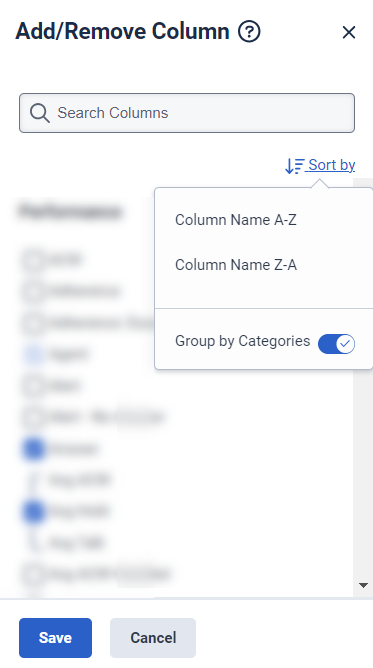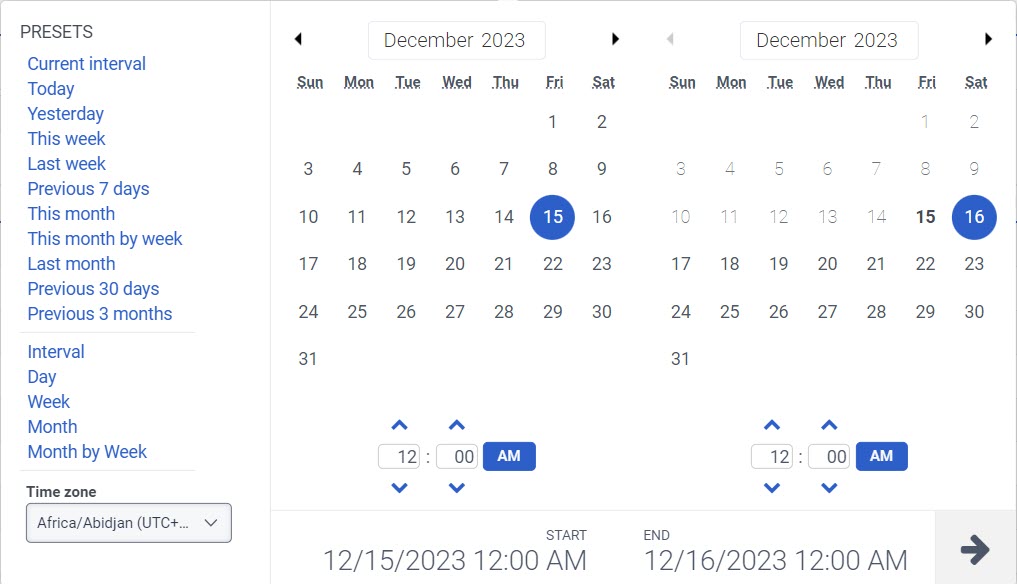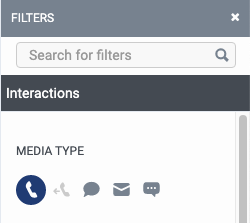Queues Performance Summary view
To see current and past metrics and data for queues, click Performance > Workspace > Contact Center > Queue Performance. Customize the view with filters and column controls.
This view performs live updates to data in the real-time columns in these situations:
- If you view a date range that includes the current interval such as today, this month, and more.
- If you apply a filter other than media type or Filter queue(s) that filters the queue list by queue name or division.
This view does not perform live updates to data if you view a historical date range that does not include the current interval.
Available columns
To view the available columns, see the Queues Performance Summary view section in the View available columns in performance views by category article.
To view the consolidated list of available columns in the performance views, see Consolidated view of available columns in performance views.
To view the list of available columns in the performance views by category, see View available columns in performance views by category.
Set a default time zone in the workspace
You can set the default time zone in the analytics workspace before viewing any analytics view.
To set the default time zone in the workspace, follow these steps:
- Click Performance > Workspace.
- On the left side, from the Time zone drop-down menu, select the required time zone as the default time zone for the analytics workspace.
For information about a specific queue, click the queue’s name to see its Queues Performance Detail view.
To view aggregate data about a group of selected queues, filter for and select multiple queues and click View as group. Genesys Cloud displays the Queues Performance Detail view with aggregate data for the queues that you selected.
To export the data in the view, click Export .
To save the view with your filter and column settings, click Save .
This view updates automatically except when you use filters from the Filters pane. To see the most current data, click Refresh .
Note: The Offer, Answer %, Abandon %, ASA, Service Level, and Avg Wait columns show metrics for inbound interactions handled in a queue. All other columns show metrics for both inbound and outbound interactions that a queue handled.
For async interactions, such as email and messaging, it takes up to 72 hours for Speech and Text Analytics metrics, such as topics and sentiment, to update in the reporting aggregate views.
Customize the view
To show only certain data, customize the queues performance summary view. For example, you can choose to show only certain columns or filter to see certain types of interactions. If you return to the Queue Summary Detail view, then your filters and column changes remain. You can also save your filter and column settings as a saved view to switch quickly between different data of interest in the same view.
Filter by queues to populate the summary row with aggregate data about those queues.
To customize analytics views, use the date filter.
To filter metrics by date or configure a custom date range, use presets. When filtering metrics for this view, select any custom date range up to 2 years.
To use a preset to filter metrics, complete the following steps:
- To display the date filter, click the date.
- In the Presets list, select a preset date option.
Date presets
| Presets | Description |
|---|---|
| Current interval | Shows data for the current 30-minute time period. |
| Today | Shows data for the time period that includes the current interval. |
| Yesterday | Shows data for the previous day. |
| This week | Shows data for a Sunday through Saturday time period. |
| Last week | Shows data for the previous week, Sunday through Saturday. |
| Previous 7 days | Shows data for the previous seven days. |
| This month | Shows data for the current month, with no extra days. |
| This month by week | Shows data for the current calendar month starting on Sunday and ending on Saturday, including extra days if the month does not start on Sunday or end on Saturday. |
| Last month | Shows data for the previous calendar month with no extra days. |
| Previous 30 days | Shows data for the previous 30 days. |
| Previous 3 months | Shows data for the previous 3 months. For example, Nov 1, 2022 – Jan 31, 2023. |
| Interval | Shows data for a 30-minute time period. |
| Day | Shows data for a single 24-hour day. |
| Week | Shows data for a Sunday through Saturday time period. |
| Month | Shows data for the exact month with no extra days. If the current month is selected, you can see the data up to the current date. |
| Month by Week | Shows data for a calendar month starting on Sunday and ending on Saturday, including extra days if the month does not start on Sunday or end on Saturday. |
To use a custom date range to filter metrics, complete the following steps:
- Click the date to display the date filter.
- Select a start date and an end date on the calendar, and click the filter arrow .
To view data for a different time period using the same date presets, click the arrows on either side of the date display. ![]()
For example, to view data for the previous day, click the Day preset, and then click the arrow on the left side of the date.
To view data for a different time zone using the same date presets, from the Time zone drop-down menu, select the required time zone. You can create and save reports with the same selected time zone.
- When filtering you can select more than one media type. Click the relevant media type to select or deselect the type.
- You cannot select the voice and callback types at the same time.
- If you select voice, the callback option will be deselected. If you select callback, the voice interaction will be deselected.
- The available media types may vary from those shown above.
The selected media type icon is displayed above the column headers. For more information about various media types and their settings, see the Set behavior and thresholds for all interaction types section in the Create and configure queues.
Data in the view can be displayed in a chart. To view the chart, click the Show/Hide chart icon .
To show or hide columns:
- Click the Pick columns icon on the right side. The Add/Remove Column pane appears.
- (Optional) To sort the columns in ascending or alphabetical order, click Sort by > Column Name A-Z.
- (Optional) To sort the columns in descending or reverse alphabetical order, click Sort by > Column Name Z-A.
- (Optional) To categorize or uncategorize the columns, click Sort by and enable or disable the Group by Categories toggle. Click the image to enlarge.

- Search or scroll to select the columns you want to view. Note: You can also use keyboard navigation to choose the columns.
- Click Save. The selected columns appear on the screen. Note: The column selections appear only after saving the changes and do not apply to the table immediately.
To rearrange the columns, click a column header and drag it.
To reset a view to default column settings, click Reset view to defaults ![]() .
.
You can select up to 20 columns.
For more information about the metrics shown in the columns, see the Available Columns section in this article.
To enter names of queues you want to view, click the Filter queue(s) search icon . Enter the name of the queue and select the queue from the search results. You can continue to enter and select additional queues to add to the view.
Filter by selecting multiple queues
You can select multiple queues to filter by.
- In the queue's row, select the check box.
- Continue selecting queue check boxes to add to filters.
- Click Add to filters.
To use the summary row above the queue rows to see the aggregate metrics for multiple queues, search for and select multiple queues. The summary row then shows the aggregate metrics for the selected queues.
View aggregate data
To view aggregate data about a group of selected queues, filter for multiple queues and click View as group. Genesys Cloud displays the Queues Performance Detail view with aggregate data for the queues that you selected.
To filter by information about the interaction, click Toggle filters panel , and then search or scroll to select the filter you want to use.
Some metrics are not relevant for all filters. For example, the "offer" metric only applies to queues, not users. If you filter by a user, then the offer column does not include data.
Interactions filters
| Filter | Description |
|---|---|
| Skills |
Displays metrics for interactions with agents who have the selected skills. Filter for multiple skills at one time by entering other skills and searching again. |
| Languages |
Displays metrics for interactions with agents who have the selected languages. Filter for multiple languages at one time by entering other languages and searching again. |
| Direction | Displays information about interactions of the selected directions. |
| Initial Direction | Displays information about interactions with the selected initial direction. |
| DNIS | Displays information for interactions with the selected DNIS numbers.
|
| Session DNIS | Displays information for interactions with the selected DNIS number. The DNIS number could have been dialed any time during the interaction.
|
| To | Displays information for interactions sent to the selected email addresses.
|
| User |
Displays information associated with the selected users. Filter for multiple users at one time by entering other users and searching again. To see and select inactive users in the User filter search, select Include inactive users. To see and select deleted users in the User filter search, select Include deleted users. |
| Wrap-up |
Displays information for interactions that have the selected wrap-up codes. Filter for multiple wrap-up codes at one time by entering other wrap-up codes and searching again. |
| Message Type |
Displays metrics for interactions of the selected ACD message type. This filter only appears if you set the media type filter to Message. If you do not have any message types selected, the view displays information for all message types. Genesys Cloud currently supports the following message types: Facebook, Instagram, Line, Open, SMS, Web Messaging, WhatsApp, and X (Twitter). Note: Line message type is deprecated. But we still support display filtering.
|
| Has Media | Only shows interactions that have multimedia content. This filter only appears if you set the media type filter to Message. |
| Provider | The source provider for the conversation. For example, Genesys Cloud EMAIL, Edge, and so on. |
| Routing Used | Displays the routing method that was used to get to the agent who answered the interaction. The routing data is relevant beginning September 5, 2020. |
| Routing Requested | Displays the routing methods that were requested for the interaction. Gives insight into each of the routing methods the conversation went through prior to being answered, abandoned, or flow-out. The routing data is relevant beginning September 5, 2020. |
| Agent Assist |
Yes displays data for interactions that had Agent Assist. No displays data for interactions that did not have Agent Assist. |
| Work Team | Displays metrics for interactions associated with the selected work team. Filter for multiple work teams at one time by entering other work teams and searching again. For more information, see Work teams overview. |
| First Queue | Displays data for the first queue of an interaction. Select the First Queue check box to retrieve queue statistics for only the first queue that the interaction occurred on. |
| External Tag | Displays information for interactions that have the External Tag attached to the conversation record. Note: External tag data is not available for web chat interactions. |
| Social Classification | Displays interactions based on one of the following options selected.
|
Notes:
- Real-time updates stop while any filters in the Filters pane are active.
- The skills and languages filters use agents’ ACD skills or languages, not the skills or languages listed in their profiles. To add an ACD skill or language to an agent, see Manage ACD skills.
- When you apply skill or language filters, the view shows the SLA. However, if the SLA is below the target, the view does not show SLA targets and the color does not change.
To filter by survey details of the interactions:
- Click Filters .
- Click the Surveys tab.
| Filter | Description |
|---|---|
| Survey Type |
|
| Survey Response Status |
|
Currently, Genesys Cloud does not save the conversation direction data for the survey-related metrics.
If you do not suppress the voice recording, you can hear the voice survey part of the recording, even if the survey status shows Error.
To filter by information about the outbound details of the interaction:
- Click Toggle filters panel .
- Click the Outbound tab.
- Search or scroll to select the filter you want to use.
Outbound filters
| Filter | Description |
|---|---|
| Campaign Name |
Name of the campaign. |
| Contact List |
Displays metrics for interactions associated with the selected contact lists. Filter for multiple contact lists at one time by entering other contact list names and searching again. |
To filter by information about the Predictive Engagement journey details of the interaction:
- Click Toggle filters panel .
- Click the Journey tab.
Journey filters
| Filter | Description |
|---|---|
| Has Customer Journey Data | Displays data for interactions that have customer journey data related to Predictive Engagement. |
| Proactive | Displays data for interactions where Predictive Engagement offered a chat during a customer's website visit based on the Predictive Engagement action map settings. |
To filter by information about External Contact details of the interaction:
- Click Toggle filters panel .
- Click the External Contact tab.
External Contact filters
| Filter | Description |
|---|---|
| External Contact | Displays information about interactions associated with the selected external contact. You can filter for:
When you filter by external contact, the contact name appears with the associated organization name. Filter for multiple external contacts at one time by entering another contact and searching again. Enable Include merged contacts to search all the contacts that relate to the external contacts in the filter. Note: You can associate each merged contact with many individual contact IDs. When you enable the Include merged contacts, all merged contact IDs are automatically added to the search. The search filters are limited to 200 total search dimensions.
For example, if you merge one contact into five other contacts, the search, performed along with the merged contacts, filters a total of six contacts. If an organization heavily uses the merged contacts, a search for a few external contacts can hit the search filter limit. |
| External Organization | Displays information about interactions associated with the selected external organization. You can filter for:
Filter for multiple external organizations at one time by entering another organization and searching again. |



